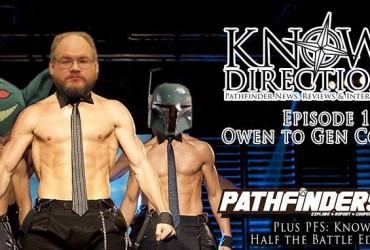With GenCon less than a day away (as of the posting of this article anyways), and as I pack my bags, I thought I might talk a little bit about preparation. How do you do it? How much is enough? How much is too much?
I’m sure many of us have been in the situation where hours are spent on lovingly crafting a number of encounters set in a very particular location. Then when the game begins the players decide to avoid the location entirely. No plan survives contact with the PCs. But at the same time, without some sort of framework for which to base your adventure, encounters can fall flat. While it is certainly possible for a GM to run an adventure with entirely off the cuff improvisation, that’s not a talent everyone has. So you must plan to a certain extent. But the question is how much?
There’s a bit of GM theory called the Five Room Dungeon that I’ve long ascribed to and from which I’ll borrow some of today’s discussion. But I highly suggest you read up on it if you haven’t heard of it before. Generally speaking, in your typical three to five hour gaming session your group is going to get through around five encounters. These can be roleplaying encounters, combats, puzzles, or whatever. Five encounters. That’s it. So that’s the simple answer. Prepare five encounters ahead of time.
But… it can get complicated. What if the PCs are exploring a dungeon? Or an open-world? Then they can go anywhere. What happens if you prepared encounter areas A, B, C, D, and E but they stumble across areas V, W, X, Y, and Z? Well, there are two ways to approach this. The first works better under the assumption that it’s a published adventure, is that you can have read ALL the encounter areas beforehand and familiarized yourself with them. So while you’re not necessarily prepared for every encounter area, at least you know enough about them to run it.
The second approach generally works better with homebrews or adventures that lack a tight narrative structure. The answer then is to simply slot in an encounter that you’ve prepared in place of one that you haven’t. So for example, the group ended the last session with the PCs at a fork in a tunnel. They tell you that they plan to go down the right corridor. So you prepare the next few encounters down that way. You get really excited about those encounters. They involve a bedchamber in shambles, a vial of some sort of performance enhancing potion, and marital dispute between a Fire Giant couple.
When the next session comes around, the party’s rogue (because he’s a jerk) decides that he wants to sneak off to the left while nobody’s looking. Well, you just spent all week preparing the Fire Giant Drama. You want to run that. Well, because you’re the GM you can make that what’s down the left corridor. Because how are your players going to know? Just remember to keep notes on what happened when and where so you don’t end up confusing yourself.
Another handy tip I’ve been doing in my off time is keeping a notebook full of names. I might be watching a movie, or waiting for the bus, or sipping my morning coffee. If I see a cool name, I jot it down. Then, when your PCs decide to question, capture, or otherwise harass some random NPC, I just open my book of names and grab one.
I’ve also been minimizing my prep quite a bit by using published monster templates. The Paizo Monster Codex, the NPC Codex, and the Inner Sea NPC Codex just to name a few have been incredibly useful in making sure my prep time goes to more important things.
So how do you prep games? How much time would you say goes into setting up an encounter compared to running it? Let us know about it in the comments section below!






Leave a Reply